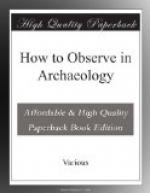[ILLUSTRATION XIV MESOPOTAMIAN POTTERY, SEALS, ETC].
[ILLUSTRATION XV: CUNEIFORM AND OTHER SCRIPTS].
II. EARLY BRONZE (Copper) AGE: First Sumerian (pre-Sargonic) Period; c. 3500-3000 B.C. Earliest Sumerian civilization.
Typical sites. Older strata at Telloh (LAGASH);
Fara (SHURUPPAK);
Tell ’Obeid (ancient name as yet unknown); Shahrein
(ERIDU).
Characteristics. Writing. First appearance of script, already conventionalized from pictographs. Cut on stone and incised on clay tablets and bricks of characteristic early style. Brick buildings, with crenellated walls (until the discovery of Tell ’Obeid supposed to date only from the later Sumerian period) of typical plano-convex bricks, baked or crude, usually with thumb-mark down length of convex side (Shahrein), or with two thumb-holes (for carrying the brick when wet?), or vent-holes (’Obeid); at first uninscribed, later with long inscriptions; measuring 10 x 6 x 2-2 1/4 ins. (Shahrein), and 8 x 6 x 2-2 1/4 ins. (’Obeid); poorly shaped and baked (see XIV, Fig. 3). Bitumen used for mortar; laid very thick. Hard white stucco on internal faces of crude brick house walls, often decorated with red, white, and black painted horizontal stripes (Shahrein.) Pottery. Wheel and hand-made; drab, fine or coarse paste, unpainted and usually undecorated. Typical shapes: (see XIV, Figs. 2 abc) mostly handleless vases, and cups, and spouted ‘kettles’ (again often resembling early Egyptian types).
Metals: Copper. Extensive use: large copper figures of animals, heads cast, bodies of copper plates fastened by nails over a core of clay with a mixture of bitumen and straw; the figures have eyes, tongues, and teeth of red and white stone and nacre (Tell ’Obeid); goat’s head with inlaid eyes of nacre (Fara). Otherwise ordinary treatment of eye shows a number of wrinkle lines round it, and it is always disproportionately large (bull’s heads, Tell ’Obeid and Telloh). Small fragments of copper or bronze on the surface of a tell should never be neglected, as there may be enough in any fragment to give an idea of possible archaic remains within the tell.
Silver. Rare. Fine engraved vase of Entemena (Telloh, Louvre).




